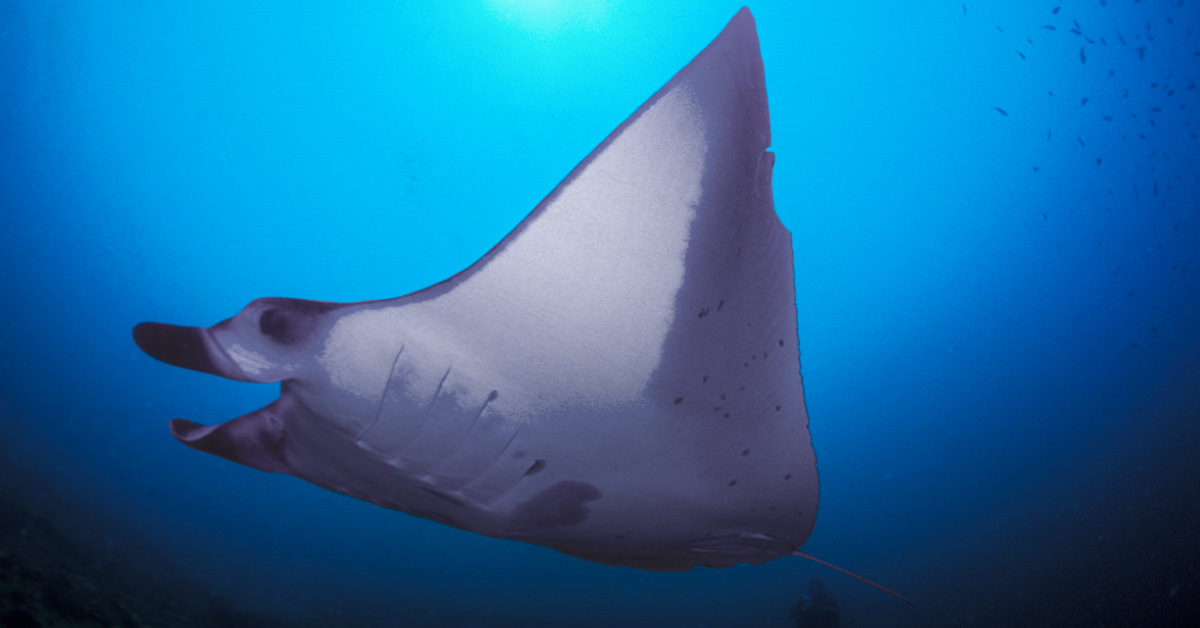The diversity you find in nature is absolutely incredible. There are so many different plants and animals with specific evolutionary traits, that just when you think you’ve seen it all, you’re confronted by something new, interesting, and at times dumbfounding in nature. Animals can range from being one color or color pattern across their species to having a wide variety. Easy examples are dogs and cats, they feature a huge spectrum of different colors and patterns.
In March 2020, a Finnish underwater photographer named Kristian Laine managed to encounter and photograph an oceanic rarity that few have ever seen in person: a pink manta ray. The photographs were taken near Lady Elliot Island in the Great Barrier Reef of Australia.
“It is very rare because I think there have only been around eight to 10 sightings since the first sighting in 2015,” Kristian said. “I felt amazed afterward but also felt like when I was at its eye level, I felt like he was smiling at me.
“He was big and I got into a touch range but obviously didn’t touch, I was super close, about a meter at best. The whole encounter lasted for about 20 to 30 minutes and he was part of a mating manta train that was just circling around a cleaning station.”
The manta ray, which has been affectionately named Inspector Clouseau after the bumbling detective in the Pink Panther franchise, is believed to be the only one of its kind swimming the oceans. Clouseau is estimated to be approximately 11 feet long and possibly as heavy as a ton and was first spotted in 2015. Researchers working with Project Manta have confirmed that the animal’s pink coloration is real and that photographs of the animal have not been doctored or photoshopped in any way [1].
Read: Deep Sea Ghost Shark Was Finally Caught on Camera – and Yes, these Pictures are Real!
Researchers weren’t immediately clear on why Clouseau appeared to be pink. Initially, they believed it could be a result of what the animal was eating, in the same way, Flamingos appear pink because of canthaxanthin, which is a pigment they acquire from their diet of shrimp and blue-green algae [2]. Other’s theorized that it was perhaps an infection in the animal’s skin.
But in 2016, a biopsy of Clouseau was taken to get the final answer. As it turns out, Clouseau’s rosy pink appearance doesn’t come from diet or an infection, but from an extremely rare genetic mutation possibly linked to a condition called erythrism, which causes an animal’s skin to appear pink or red [3].
Manta rays like Clouseau have a lot more in common with whale sharks than they do with string rays, a similar-looking animal. Rays are filter feeders that eat plankton and krill through a toothless mouth. Generally, manta rays come in three distinct color patterns, black and white, white, or black. Scientists don’t believe that Clouseau’s pink skin color puts it at a disadvantage from an evolutionary standpoint. Clouseau is not likely to be the target of predators specifically due to its skin color and should have no trouble reproducing.
In the future, we may see more manta rays like Clouseau, provided we humans treat the species, and the ocean as a whole, with respect. Reef manta rays are considered a vulnerable species by the IUCN. [4] The total population count is not presently known. The greatest threats to manta rays are fishing and being caught in discarded fishing gear, or bycatch. Some parts of the ray are used in traditional medicine in Asia. [5]
Keep Reading: Researchers Capture Rare Footage of Fish That Sees Through its Own Head
Sources
- “Project Manta.” Biomedical
- “Why are flamingos pink?” Science Focus. Thomas Ling. February 27, 2021.
- “This is the only pink manta ray in the world — and people are going crazy over it.” ZME Science. Tibi Puiu. February 12, 2020.
- “Reef Manta Ray.” IUCN Red List
- “MANTA RAY FACTS.” See the Wild

